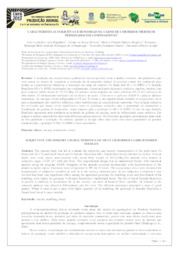Características subjetivas e sensoriais da carne de cordeiros mestiços terminados em confinamento.
Características subjetivas e sensoriais da carne de cordeiros mestiços terminados em confinamento.
Author(s): ROGERIO, M. C. P.; ALBUQUERUE, F. H. M. A. R. de; DUARTE, T. F.
Summary: Resumo: A avaliação das características qualitativas da carcaça bem como a análise sensorial, são parâmetros que vem somar no intuito de completar a avaliação do desempenho animal. O presente estudo foi conduzido para avaliar as características subjetivas e sensoriais da carne de cordeiro (½ Santa Inês-SI x ½ SPRD e ½ Somalis Brasileira-SB x ½ SPRD) terminados em confinamento. Foram utilizados dezesseis cordeiros, machos, inteiros com peso corporal médio inicial de 19,7±2,0kg. Os animais foram alojados em baias coletivas (15,25 m2) com piso de chão batido. O delineamento utilizado foi em blocos ao acaso. Utilizou-se o software SAS® 9.1 para as análises estatísticas. As carcaças foram refrigeradas a 4oC por 24 horas e, em seguida foram extraído os Longissimus dorsi para a mensuração das variáveis subjetivas como também para as características sensoriais. Na avaliação subjetiva foi verificado que houve efeito significativo entre os genótipos avaliados para a quantidade de marmoreio e distribuição da gordura de marmoreio, sendo maiores para o genótipo ½ SB x ½ SPRD. O fato da raça Somalis Brasileiro apresentar uma tendência ao acúmulo de gordura na carcaça, pode ter influenciado essas variáveis. Em relação à análise sensorial foi observada diferença apenas para cor. Os diferentes genótipos apresentaram uma carne de boa qualidade e aceitação. No entanto, quando se desejar obter uma carne com maior quantidade de gordura intramuscular, o genótipo ½ SB x ½ SPRD é mais satisfatório. [Subjective and sensory characteristics of meat crossbred lambs finished feedlot]. Abstract: The present study was led to evaluate the subjective and sensory characteristics of the lamb meat (½ Santa Inês-SI x ½ undefined breed and ½ Somalis Brazileira-SB x ½undefined breed) finished in feedlot. Sixteen lambs were used, males, non-castrated with initial body weight of 19,7±2,0kg.The animals were housed in collective cages (15,25 m2) with dirt floor. The experimental design was in randomized blocks with statistical analysis using the program SAS®. Slaughter of the animals occurred mechanically with desensitization of the atlanto-occipital region. Carcasses were refrigerated to 4oC for 24 hours. The Longissimus dorsi were extracted for measurement of subjective variables as well as to the sensory characteristics. In the subjective evaluation it was verified that there was significant effect among the appraised genotype for marbling score and distribution of fat marbling, were higher for genotype ½ Somalis Brazileira x ½undefined breed. The fact of breed Somalis Brazileira to present a tendency to accumulate fat in the carcass, can have influenced those variables. In relation to the sensorial analysis was observed differentiates just for color. The different genotypes presented a meat of good quality. When if want to get a meat with higher quantity of fat marbling, the genotype ½ Somalis Brazileira x ½undefined breed is more suitable.
Publication year: 2013
Types of publication: Paper in annals and proceedings
Unit: Embrapa Goats & Sheep
Observation
Some of Embrapa's publications are published as ePub files. To read them, use or download one of the following free software options to your computer or mobile device. Android: Google Play Books; IOS: iBooks; Windows and Linux: Calibre.
Access other publications
Access the Agricultural Research Database (BDPA) to consult Embrapa's full library collection and records.
Visit Embrapa Bookstore to purchase books and other publications sold by Embrapa.

